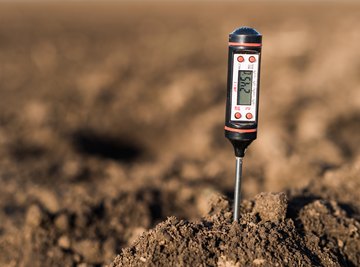
Even for those who would prefer to avoid learning about science, it would be difficult to negotiate the world without hearing regular references to something called pH. If you don't have to know what it is for chemistry class, you're likely to see references to pH level, and associated terms like acidity and alkalinity, if you merely watch a few shampoo commercials.
The pH scale is a tool chemists have devised to measure how acidic (or alkaline, the opposite of "acidic") a solution is. It is used every day in countless applications, from checking whether the chlorine level in your hot tub is where it should be to allowing biochemists to figure out ideal conditions for reactions affected by acidity to occur.
The pH scale, like a lot of tools used in physical science, is not what you'd call an "intuitive" scale, like one that ranges from 0 to 10 or 1 to 100 used for typical quiz scores or percentages. But once you develop a deep appreciation for what the number means in terms of the behavior of molecules in an aqueous solution (molecules dissolved into component atoms and molecules in water), the whole scheme not only makes sense but opens new doors to a whole new understanding of chemistry.
What Is the pH scale?
The abbreviation pH stands for "potential of hydrogen ion." The term was coined by the Danish biochemist Søren Sørenson, who defined the "p" as instructions to take the negative of the logarithm of the hydrogen ion concentration, written [H+]. pH is the negative logarithm of the molarity of H, which is a measure of total ions per unit volume rather than mass per unit volume.
Mathematically, the pH definition is
What Are Moles and Molarity?
In much of physical science, the idea of "concentration" applies to masses of particles rather than their other properties. For example, if 5.85 grams (g) of plain salt (sodium chloride, or NaCl) is dissolved in 1,000 milliliters or mL (1 liter or L) of water (H2O), you can then express the concentration of sodium chloride in water in this case as 5.85 g/L, or 5.85 mg/mL, or other equivalent units.
In chemistry, however, the "amount" of a substance that matters is not how many grams or kilograms of it there are, but how many individual atoms or molecules there are. This is because atoms and molecules react with each other based on atomic and molecular ratios, not mass ratios.
Different kinds of atoms (that is, different elements) have different masses, with the number of grams in 1 mole (6.02 × 1023 individual particles) given in the element's "box" in the periodic table of elements (see the Resources).
For example, one molecule of H2O has two hydrogen atoms and one oxygen atom. Each H has a mass of about 1 g, while an O atom has a mass of just under 16 g. Thus while 16/18 = 88.9 percent of an water molecule's mass consists of oxygen, water always has a 2-to-1 ratio of H to O atoms.
This concept is used to establish molar concentration, or moles per liter, designated M. As it happens, the molar mass of Na is 23.0 g and that of chlorine is 35.5 g, so 1 mole (1 mol, in calculations) of NaCl has a mass of 58.5 g. 5.85 g is 1/10th of this, so 5.85 g NaCl/1 L = a 0.1 M NaCl solution,
What Is a Logarithmic Scale?
If you are unfamiliar with logarithms, or logs, think of them as representing an easy ways to compress the true variability of a quantity into a more mathematically relatable form. Logs are exponents handled in non-superscript form, which requires mathematical finagling and usually a calculator.
The part you need to know is that for every factor of 10 increase in concentration of hydrogen ions, pH will decrease by 1 integer unit and conversely. This means a solution with a pH of 5.0 has ten times the [H+] of a solution with a pH of 6.0, and 1/1,000th the [H+] of a 3.0-pH solution.
- Both acid strength (that is, the inherent properties of individual acids) and acid concentration (which you can change in the lab) determine a solution's pH.
How Is pH Measured?
As noted, a 1-molar (1M) solution of pure hydrogen ions (without an associated anion) has a pH of 0. This is not seen in nature and is used as a reference point for measuring pH using an electrode that is part of a pH meter. These are calibrated to translate voltage differences between the reference solution and a solution of interest into a pH value for the latter.
1 mole of ions per liter means about 6.02 × 1023 individual molecules or atoms (i.e., individual particles) per liter of solution.
What Is the Significance of pH?
Common values of pH include about 1.5 for stomach acid, about 2 for lime juice, 3.5 for wine, 7 for pure water, about 7.4 for healthy human blood, 9 for bleach and 12 for household ammonia. The latter two compounds are strongly basic, and can exert physical damage just like acid can, albeit by a different mechanism.
An anion circulating in blood called bicarbonate (HCO3−), which forms from water and carbon dioxide, keeps the blood somewhat alkaline and acts as a "buffer" in case H+ ions rapidly accumulate in blood, as when breathing is interrupted for prolonged periods.
You have perhaps seen advertisements for "antacids," which are substances that, in contrast to acids, can accept protons, often by donating a hydroxyl (−OH) group that accept the proton to form a water molecule.
The resulting "sweeping up" of H+ ions in the stomach from the hydrochloric acid the stomach naturally secretes can provide relief from the damaging effects of acid on internal membranes.
Example pH Calculations
Example: What is the pH of a solution with an [H+] of 4.9×10−7 M?
pH=−log[H+] = −log[4.9 × 10−7] = 6.31.
Note that the negative sign accounts for the fact that the small concentrations of ions seen in measured solutions would produce a scale with negative results otherwise, because of the negative exponent values.
Example: What is the hydrogen ion concentration of a solution with a pH of 8.45?
This time, you put the same equation to use in a slightly different way:
8.45 =−log[H+], or −8.45 = log[H+].
To solve, you use the fact that the number in brackets is just the base of he log, 10, raised to the value of the log itself:
[H+] = 10−8.45 = 3.5 × 10−9 M.
Online pH Calculator
See the Resources for an example of a tool that allows you to manipulate the identity and concentration of acids in solution in determining associated pH values.
Note that as you experiment with different acids in the drop-down list provided and use different molar concentrations, you will discover an interesting fact about pH: It depends on both the identity of the acid (and thus its inherent strength) and its concentration. A weaker acid in a higher molar concentration can therefore produce a solution with a lower pH than a sufficiently dilute solution of a stronger acid.
References
Resources
About the Author
Kevin Beck holds a bachelor's degree in physics with minors in math and chemistry from the University of Vermont. Formerly with ScienceBlogs.com and the editor of "Run Strong," he has written for Runner's World, Men's Fitness, Competitor, and a variety of other publications. More about Kevin and links to his professional work can be found at www.kemibe.com.
